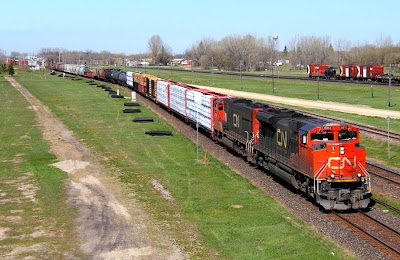 Guest photographer Ken McCutcheon: photographer, BC Rail RTC and Railfan & Railroad magazine editor's western Canadian railfan guide shares some unusual photos taken in Saskatchewan this June with Trackside Treasure.
Guest photographer Ken McCutcheon: photographer, BC Rail RTC and Railfan & Railroad magazine editor's western Canadian railfan guide shares some unusual photos taken in Saskatchewan this June with Trackside Treasure. On June 14, CP switcher K31 (using the term switcher loosely here because the power is three SD90MAC's: 9101-9153-9140) left Moose Jaw, Saskatchewan heading for Assiniboia. A dimensional load of pipe for Shaunavon, a Saskatchewan green grain car, and JLCX SD40-2 5643 headed to Sherritt Coal's Prairie Mines at Poplar River are among the consist. It looks like a train one might see on a model railway, except that's one heck of a scenic backdrop.
On June 14, CP switcher K31 (using the term switcher loosely here because the power is three SD90MAC's: 9101-9153-9140) left Moose Jaw, Saskatchewan heading for Assiniboia. A dimensional load of pipe for Shaunavon, a Saskatchewan green grain car, and JLCX SD40-2 5643 headed to Sherritt Coal's Prairie Mines at Poplar River are among the consist. It looks like a train one might see on a model railway, except that's one heck of a scenic backdrop. The Fife Lake Railway, from Assiniboia to Coronach is the route 5643 would have to follow. Problem is, there's a 200-foot sinkhole along the line. PRMX 6973 needs rebuilding, and will be replaced by 5643. To facilitate the switch, 6973 headed north from Coronach to Scout Lake on June 15 with five ballast cars of CN lineage of three different types. The two orange ones are former slabside CN covered hoppers. After running around the empty cars, they were pushed to the sinkhole site. The empties traversed the sinkhole, but since a locomotive couldn't tiptoe over, another crew had deadheaded south from Assiniboia with ex-BNSF B30-8W 575 to pick them up on the other side of the sinkhole.
The Fife Lake Railway, from Assiniboia to Coronach is the route 5643 would have to follow. Problem is, there's a 200-foot sinkhole along the line. PRMX 6973 needs rebuilding, and will be replaced by 5643. To facilitate the switch, 6973 headed north from Coronach to Scout Lake on June 15 with five ballast cars of CN lineage of three different types. The two orange ones are former slabside CN covered hoppers. After running around the empty cars, they were pushed to the sinkhole site. The empties traversed the sinkhole, but since a locomotive couldn't tiptoe over, another crew had deadheaded south from Assiniboia with ex-BNSF B30-8W 575 to pick them up on the other side of the sinkhole. Is this a shortline in Saskatchewan or BNSF in South Dakota? Turns out 6973 did cross the site gingerly, and later in the day 5643 made it to Coronach for delivery to Prairie Mines. The ballast cars and 575 pass through a verdant, rain-swelled prairie landscape.
Is this a shortline in Saskatchewan or BNSF in South Dakota? Turns out 6973 did cross the site gingerly, and later in the day 5643 made it to Coronach for delivery to Prairie Mines. The ballast cars and 575 pass through a verdant, rain-swelled prairie landscape. On June 16, 575 and the now-loaded ballast cars are dumping ballast at Mi 15 Shaunavon Sub in the Land of Living Skies.
On June 16, 575 and the now-loaded ballast cars are dumping ballast at Mi 15 Shaunavon Sub in the Land of Living Skies. Big sky country, BNSF and ballast...only in Saskatchewan.
Big sky country, BNSF and ballast...only in Saskatchewan.Running extra...
And who said Saskatchewan is flat and boring? There's more to those wide-open spaces than meets the eye. While the number of branchlines and grain elevators have dwindled, new shortlines are springing up and working hard to wring income from their inherited trackage and previously-owned equipment. Thanks again to Ken for keeping track of these operations and sharing his knowledge and photographs of them with those of us who live elsewhere.
Watch for Trackside Treasure's third anniversary contest, coming soon. You could win a somewhat-coveted Trackside Treasure prize pack containing some unique items, the nature of which I haven't exactly narrowed down yet. But I will, loyal readers. I'll be schlepping over to the prize bin and picking out some goodies you'll give your eye teeth to win. Get those thinking caps ready...
Posting some lighter fare, since it's summertime and the livin' is easy. How is it possible to gain weight while camping? I thought I did all the right things: kayaking to burn calories, limiting myself to one (1) can of beer a day, and not roasting too many marshmallows. Oh, and relaxing in a lawn chair reading railway magazines by beautiful Lake Ontario. Maybe too many magazines...







































